
Vol. I, No. 1, March 2023
Operating safe hayrides
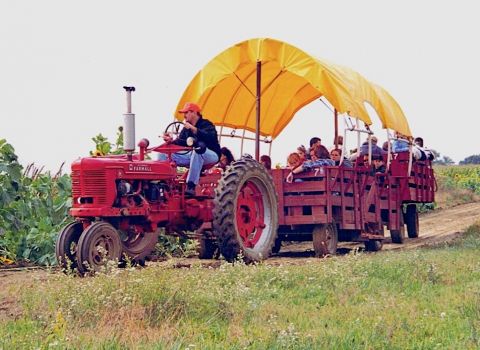
Hayrides are popular and enjoyable attractions at agritourism farms and other entertainment facilities such as fairs and parks. However, hay wagon rides can be very dangerous if not operated safely. Our research has found that hayride accidents in the U.S. since 2000 have resulted in at least 204 injuries and 24 deaths, 15 of which were children, one as recently as last year. Here are the details.
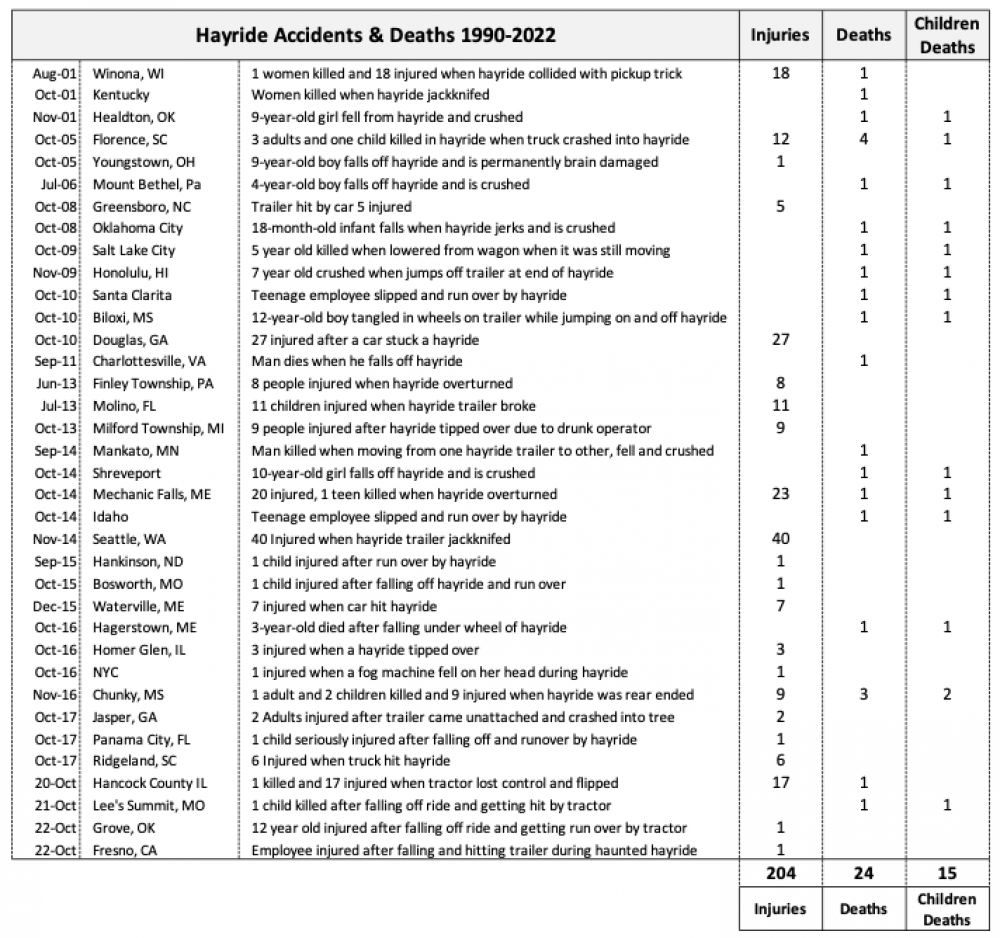
Over our company's 28 years of agritourism consulting and design work, we have visited very few farms that were operating safe hayrides. We have always prioritized advising those clients on needed improvements to make their hayrides safe. Fortunately, most followed our advice, making visiting their farms much safer.
One thing to remember when thinking about hayride safety is that many parents do not adequately monitor their children, and many are oblivious to the risks that hayrides can have for their children. So safe design and operation of hayrides must consider that unsupervised children may be on the ride, even if their parents are present. It is also important to understand the young children have not grasped the concept of cause and effect, so they will often put themselves in a dangerous situation that an adult never would. One example is climbing under a haywagon when it is stopped, not recognizing that when it starts to move they could be injured.
The significant causes of hayride injuries and deaths are:
- The rider falling off the ride
- The tractor losing control
- The wagon disconnecting from the tractor and crashes
- Collison with a vehicle on a public road
- The tractor and haywagon jackknifing
- Young children jumping off the hayride
- The rider moving from one wagon to another wagon
Here's a summary of essential safety design and operating procedures every farm or venue that operates a hayride should follow:
- The hayride route should have non-climbable barricade-type fencing along its route whenever it is in or near areas where visitors will be so there is no possibility of anyone, especially children, wandering into the path of the hayride. The hayride path should NEVER cross or travel through any areas that the public has access to. At the loading and unloading areas, the fencing should have gates operated only by the loading/unloading staff.
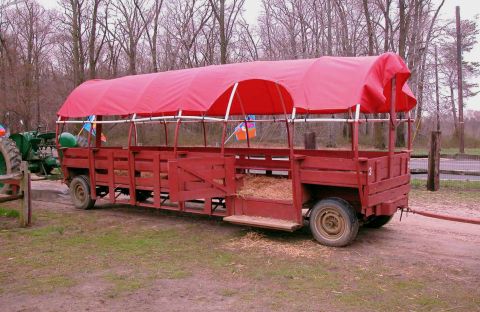
A safe hayride wagon
- The hay wagon must have railings and seating. Enclosure railings should be designed to prevent children from crawling through or climbing them. The front bulkhead railing must be adequately tall, at least 30" and sturdy to prevent anyone from falling forward out of the wagon and being run over. If the front of the wagon has seats or haybales for seating, the bulkhead railing should be 30" higher than the seating, as children will stand on the seats. There should be sturdy steps with handrails. The loading opening on the wagon should have a gate or enclosure that is kept shut other than when loading or unloading. Double wagons should NEVER be used.
- The loading area should have a sign with the safety rules for passengers.
- Have separate unloading and loading areas. To speed loading, the loading area can have a corral fenced area where the number of visitors the wagon can hold have been pre-counted and are waiting.

- Before loading or unloading, the tractor should come to a complete stop, be put in neutral, and the brake engaged. If the average grade of the ground is greater than 2%, the driver should remain on the tractor.
- Only after the tractor stops in the unloading area, is put in neutral, and the brake engaged should the unloading staff open the wagon gate and assist people off.
- Once a wagon is unloaded, the unloading staff should close the barricade exiting gate, the wagon should be inspected for lost items, the tire inflation on the wagons and tractor eyeballed, and the area around and under the wagon inspected to make sure there are no people or children, and only then should the tractor driver be signaled to proceed to the loading area.
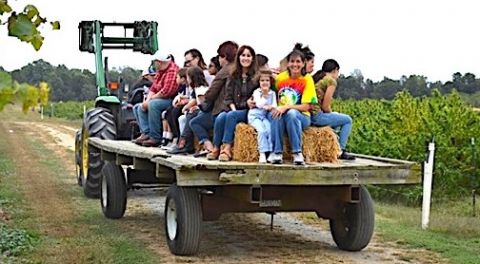
A dangerous hayride
- Once the wagon is loaded, verbal safety instructions should be given to the riders. Before the ride starts, a staff member on the ground should inspect the area around and under the wagon to ensure there are no people or children. Only then should the tractor driver be given the okay to proceed.
- There should be well-organized written loading and unloading procedures.
- Ideally, communication between the loading and unloading staff and the driver should be via two-way radio. Otherwise, the driver's go-signal should be visual, crystal clear, and not mistakable.
- The hayride path should be kept smooth as depressions and ruts can cause wagons to grab hold and jerk, bouncing riders around. There should be no steep areas. All trees and bushes along the path must be trimmed so branches won't hit riders. The trail should NEVER cross a public road.
- Tractors and hay wagons should be thoroughly inspected at the beginning of each day. There should be a written inspection checklist where the drivers check off each item and sign and date the sheet. This helps assure the procedures will be appropriately followed.
- A tamper-proof locking hitch pin must connect the wagon to the tractor. The wagon must have a safety chain connecting the wagon's front axle to the tractor's drawbar or rear axle.
- Tractors should have rear-view mirrors that give a full view of the wagon.
- For adequate traction and braking, the tractor pulling the wagon must weigh more than the gross weight of the wagon when full of people.
- All wagons should have a tour guide riding in the wagon who has two-way radio communication with the tractor driver. Tractor noise prevents a driver from hearing anything shouted from the wagon if there is a problem.
- Travel on public roads should be avoided. In 1989 in New Brunswick, Canada, 13 wagon riders died and 45 were injured when a logging trailer crashed into a hayride. In 2016 in Chucky, Mississippi, three people were killed when a pickup truck rear-ended a hay wagon traveling on a public road.
-
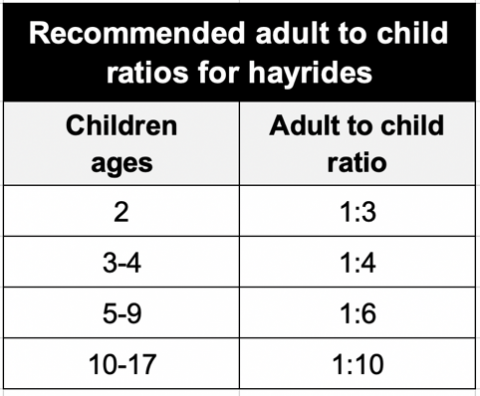 Due to the hazardous nature of hayrides, children's field trip
hayrides should have higher adult-to-child ratios than classroom ones. The
chart shows recommended ratios:
Due to the hazardous nature of hayrides, children's field trip
hayrides should have higher adult-to-child ratios than classroom ones. The
chart shows recommended ratios: -
Training is essential for all staff involved. All tractor drivers
should be trained in the operation of the tractor they will be driving,
including how to properly start and stop smoothly, and on driver safety
rules. They should be given a tractor driver road test. Just because
employees know how to drive a tractor does not mean they understand how to
drive a hayride. All employees responsible for loading, unloading, and
supervising hayrides must also be trained.
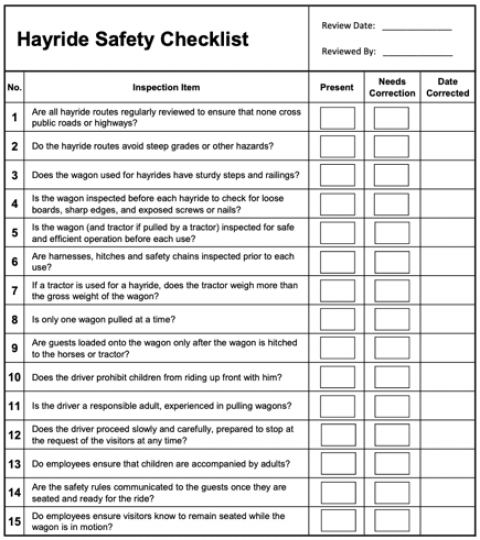 There should be a pocket-size
checklist of all procedures each staff member keeps and uses.
There should be a pocket-size
checklist of all procedures each staff member keeps and uses. - Daily checklists for hayride path, tractors, and wagons should be filled out at the beginning of each day. There should be annual tractor and wagon checklists.
- There should be safety rules and training for actors and staff of haunted hayrides.
The American Society for Testing and Materials, known as ASTM, has developed a Standard Practice for Hayride Attractions (F3168 - 20). It applies to hayrides at amusement, entertainment, recreational, or agritourism businesses, including but not limited to family entertainment centers (FECs), camps, shopping centers, seasonal attractions, pumpkin patches, corn mazes, farms, fairs, and municipal parks. The Standard also incorporates by reference with appropriate noted modifications ASTM F770 - 22, Standard Practice for Ownership, Operation, Maintenance, and Inspection of Amusement Rides and Devices. The standards cover many aspects of hayrides, including operations, design, signage, maintenance, and documentation. The F3168 Standard's appendix has many good examples of different needed checklists, rules, and reports.

While the Standard covers many important aspects of operating hayrides, it falls short of many safety standards. For example, they require an 18" bulkhead at the head of hay wagons, which is inadequate when children are on the wagon. They fail to require sides and rear barriers. Our CEO has been an expert witness in two cases where children were injured on a hayride. One injury was due to the hay wagon lacking side barriers. They also fail to address things like fencing offloading areas, never driving through areas accessible to the public, having a designated wagon loader, and many other standards to address safety.
The purpose of the ASTM Standard Practice for Hayride Attractions is to provide consistent standards for the operation of hayrides, including safety for riders, attendants, operators, and spectators. Although the standards are voluntary, ASTM standards often become the de facto standard by which liability is determined in court lawsuits when hayride accidents happen.
Hayrides are a great fun attraction for visitors. Just make sure to take the time and effort to make sure yours is safe.
Additional resources:
- Safeagritourism.org has a whole series of checklists not only covering hayrides, but also things like corn mazes, inflatables, play areas, petting zoos, etc. They also offer walkthroughs with photos and questions followed by an explanation of the correct answer.
Subscribe to Agritourism Today



